We’re going to be counting Golden Eagles for the National Eagle Center and Hawkwatch International on January 21, so I decided to brush up on my knowledge. Understanding a species’ behavior, seasonality, and body plans can help you identify birds in flight.
Bald and Golden Eagles, Turkey Vultures, and Ospreys
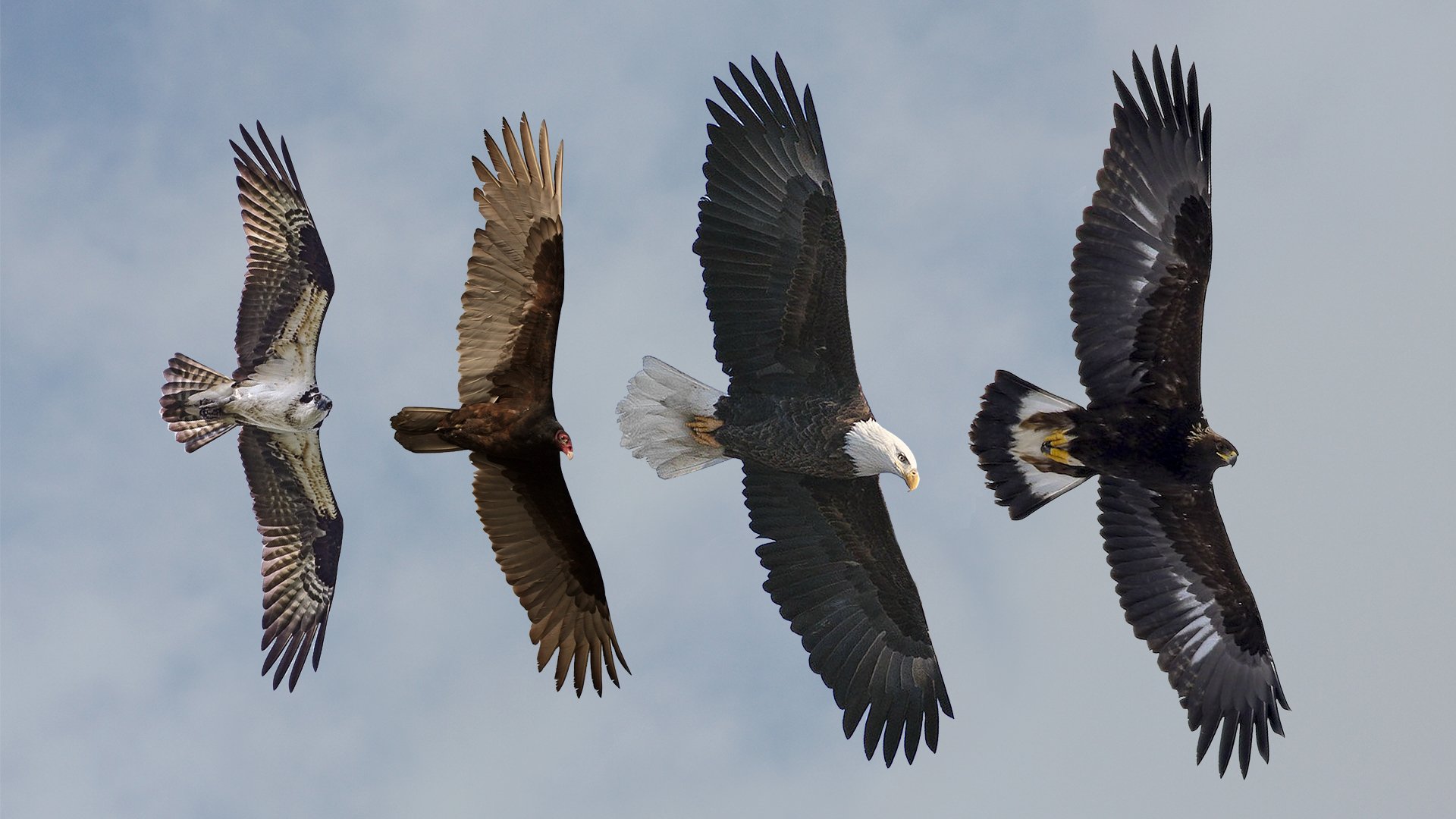
Left to right: Osprey, Turkey Vulture, Adult Bald Eagle, Subadult Golden Eagle
Bald Eagles: Flat Soar | Driftless Area: Year Round | Favorite Food: Fish | Genus: Sea Eagles
Bald eagles are built for soaring, with long broad wings, large wing slots, and broad, wedge-shaped tails. They hold their wings flat in flight, migrate during the day, and use wind corridors – geographical features that concentrate and amplify wind – whenever possible. A stiff tail wind will send migrating eagles aloft in the thousands, especially over surfaces with little opportunity for thermal soaring. The bald eagle body plan and low-aspect wings – i.e. large, broad wings relative to its overall surface area – are most suited to low-angle, low-energy soaring flight. Bald eagles breed in Iowa, Wisconsin, and Minnesota and can be seen there year round.
Bald Eagles eat a wide variety of prey, although they prefer fish. They usually swoop in shallowly over a body of water, braking heavily as they swing their feet down and hook into fish near the top of the water column. They don’t dive beneath the water like ospreys, although they can swim and will sometimes fish from the bank of a river. In the winter, you might see them nesting, usually near a body of water. Wintering non-territorial eagles congregate in huge groups near open water on the main channels of large water systems.
Golden Eagles: Slightly Inclined Dihedral Soar | Driftless Area: Winter | Favorite Food: Mammals & Birds | Genus: True Eagles
Juvenile Bald Eagles are frequently mistaken for Golden Eagles. Look for field ID points and think about the time of the year and the bird’s behavior, including its flight. Golden Eagles are named for their beautiful golden napes. They soar but frequently set their wings in a shallowly inclined dihedral: not as flat as an eagle, but not as V-shaped as a Turkey Vulture. They don’t summer in the Driftless and they don’t eat fish, which means that the large, brown eagles we see in July are juvenile Bald Eagles, not Golden Eagles. During the winter, look for Golden Eagles in deep Driftless forest draws and coulees – steep terrain where wild turkeys, rabbits, deer, and other prey can be found. They don’t commonly take prey over water and, at least in the Driftless, you are less likely to find them on the main channel of a large river system.
Golden Eagles tailor their hunting techniques to suit the terrain, conditions, and prey they are hunting: diving from a high soar, quietly ambushing from a low perch, walking up to and seizing prey on the ground, or flying low over hills and valleys to conceal their approach. In flight, they can turn tightly – look for them to wind the gyre like a Red-Tailed hawk! – flap more shallowly, and dive at surprisingly high speeds. Their rounder, narrower wings make them a little more agile than Bald Eagles. Look for them in ones and twos – Golden Eagles do not congregate.
Turkey Vultures: Steeply Inclined Dihedral Soar | Driftless Area: Summer | Favorite Food: Carrion | Genus: Cathartes
Turkey vultures gather in a large kettles as they scent for carrion, cocking their large wings into an energy efficient dihedral or “V” shape. As wind strikes one wing or another, tipping the vulture right or left, one wing tips high and the other tips low. Wind flows under the low wing, pushing the vulture and righting it until it tips again. This allows them to minimize flapping and exploit the smallest of air currents as they soar slowly through the sky. While they sacrifice some maneuverability, their food – carrion – doesn’t require agility to catch. They do not winter in the Driftless.
Look for groups of Turkey Vultures slowly tilting and soaring as they ride the wind and look for food. While Bald Eagles and Turkey Vultures can look physically similar, their flight patterns and shapes are very different. Bald Eagles flap and fly flat, while Turkey Vultures tilt and fly in a ‘V’. Once you recognize their flight ways, you’ll find it easy to tell the difference!
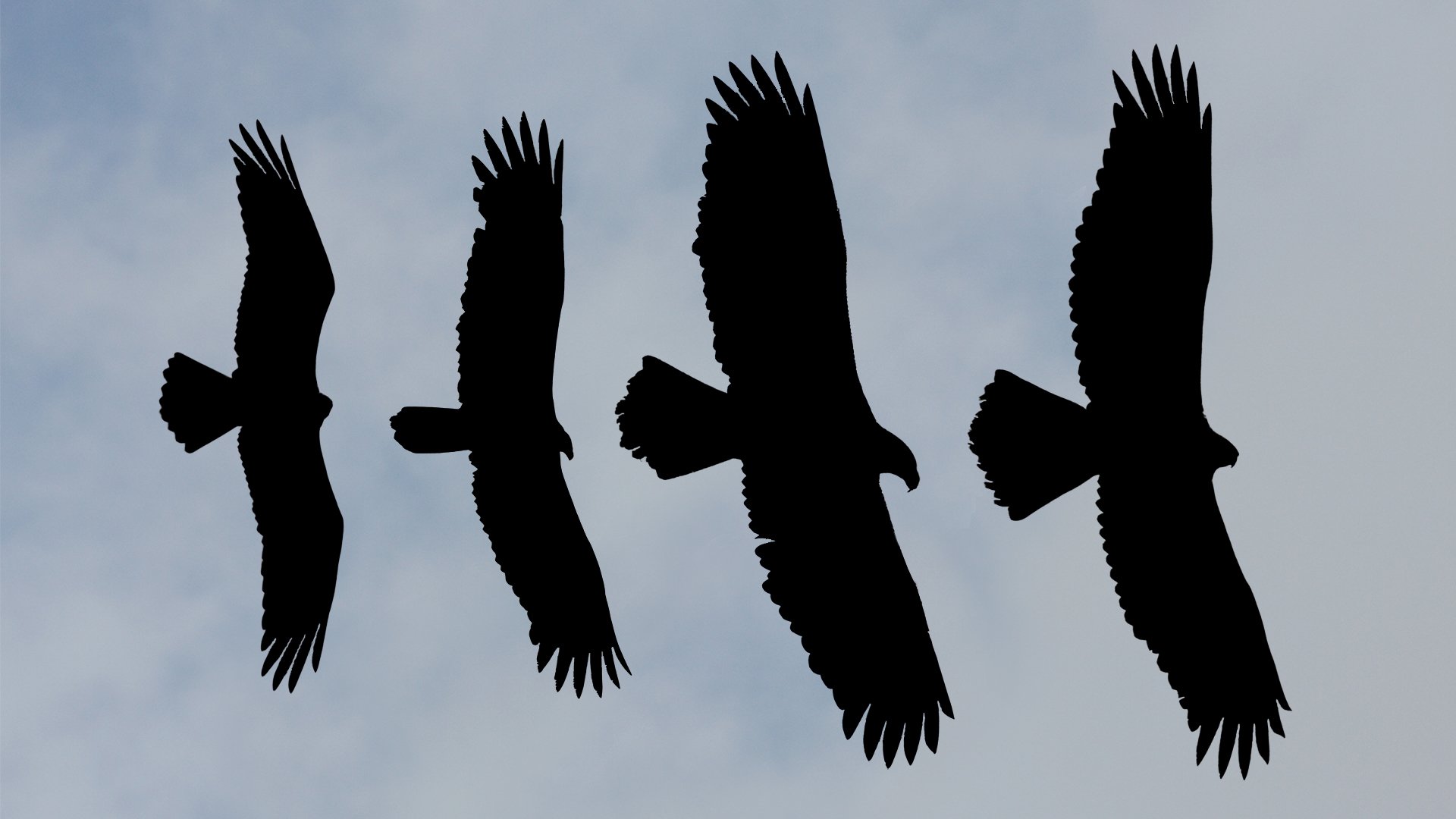
From Left to Right: Osprey, Turkey Vulture, Bald Eagle, Golden Eagle. See the difference?
Ospreys: M-Shaped Soar | Driftless Area: Summer | Only Food: Fish | Genus: Pandion (Sole Member)
Ospreys soar through the air with their slender, angular wings cocked in a bow that resembles the letter ‘M’. While Bald Eagles and Osprey both eat fish, they catch them in different ways. Bald Eagles swoop shallowly over the water’s surface but Osprey cock their wings and plunge in steeply, sometimes completely submerging themselves in pursuit of fish, their only prey.
Ospreys are obligate fish eaters, which means they don’t winter in the Driftless. In the summer, look for them perched by or soaring in circles over open water with an abundant supply of fish. Their (relatively) small size, angular wings, and lighter, agile flight make them easy to recognize!
Rough-Legged Hawks, Red-Tailed Hawks, and Northern Harriers
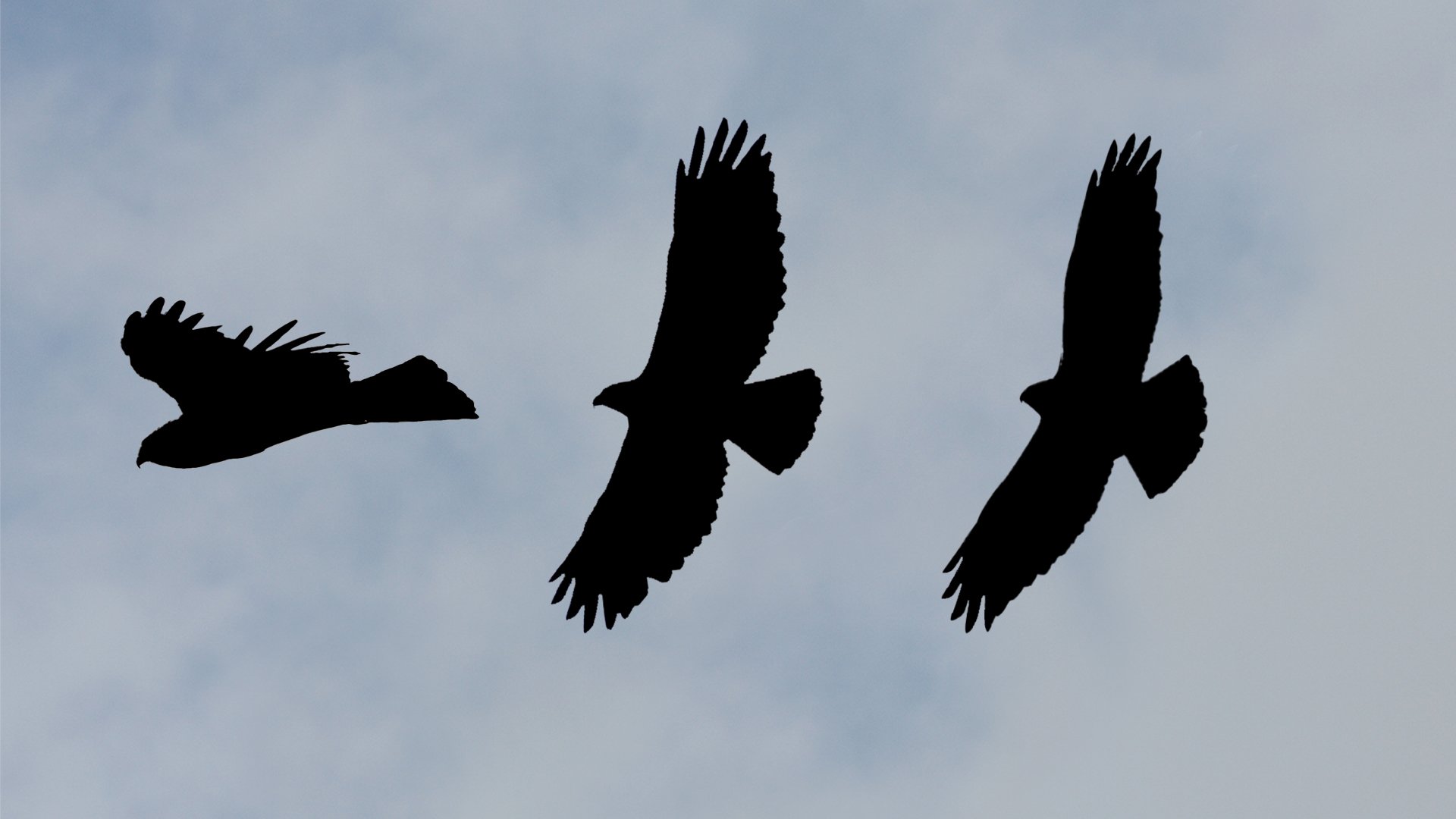
Left to right: Northern Harrier, Red-Tailed Hawk, Rough-Legged Hawk
Northern Harrier: Steeply Inclined Dihedral Drift | Driftless Area: Year-Round | Favorite Food: Mammals | Genus: Circus
What’s that hawk-sized bird quartering low and slow or hovering over a winter marsh or grassy plain? It’s a Northern Harrier! Northern Harriers are specialist tall grass hunters with facial discs and white rump patches. Like owls, their facial discs allow them to detect and catch prey they can’t see.
Look for Northern Harriers drifting or hovering over open grasslands, harvested fields, and marshes as they hunt for prey. Dihedral flight allows them to soar very slow and very low, but they have a long tail and wings more like a falcon, which helps them roll and twist. I often think of them as having ‘angel-like’ shapes. Their facial discs are unique among North American diurnal birds of prey.
Rough-Legged Hawks: Slightly Inclined Dihedral Soar | Driftless Area: Winter | Favorite Food: Mammals | Genus: Buteo
Like Northern Harriers, Rough-legged Hawks prefer open country and have white rump patches. However, they fly very differently. A harrier quarters low and slow, while a Rough-legged Hawk tends to be higher off the ground. It will hover, but doesn’t drift like a harrier. You won’t see Rough-legged hawks in the summer in the Driftless, since they breed in the Arctic.
Look for wintering Rough-legged Hawks perched on slender tree branches and posts or soaring and hovering over open grasslands, harvested fields, and marshes. You won’t mistake them for harriers, but you might mistake them for Red-tailed Hawks! They are roughly the same size and, like red-tails, come in many different colors and patterns. But in general, their wings are narrower and less rounded, they don’t have a belly band, their tails are striped, and they have white rumps. Again, you won’t see them in the Driftless in the summer.
Red-tailed Hawks: Slightly Inclined Dihedral Soar | Driftless Area: Year Round | Favorite Food: Mammals and Reptiles | Genus: Buteo
Red-tailed Hawks tailor their hunting techniques to suit the terrain, conditions, and prey they are hunting, but you’ll most likely see them soaring in wide circles high over a field, or perched in a tree or on a tall pole, scanning the ground for prey.
Red-tailed Hawks and Rough-legged Hawks utilize the same areas, habitat types, and prey species during the winter. But Red-tailed Hawks fly a little differently – look for them winding slow circles high over a field – show a greater preference for perching in trees, use higher trees, forage in wetter areas, and hunt from groves of trees or woodlot borders more than Rough-legged Hawks do.
So What Is That Bird?
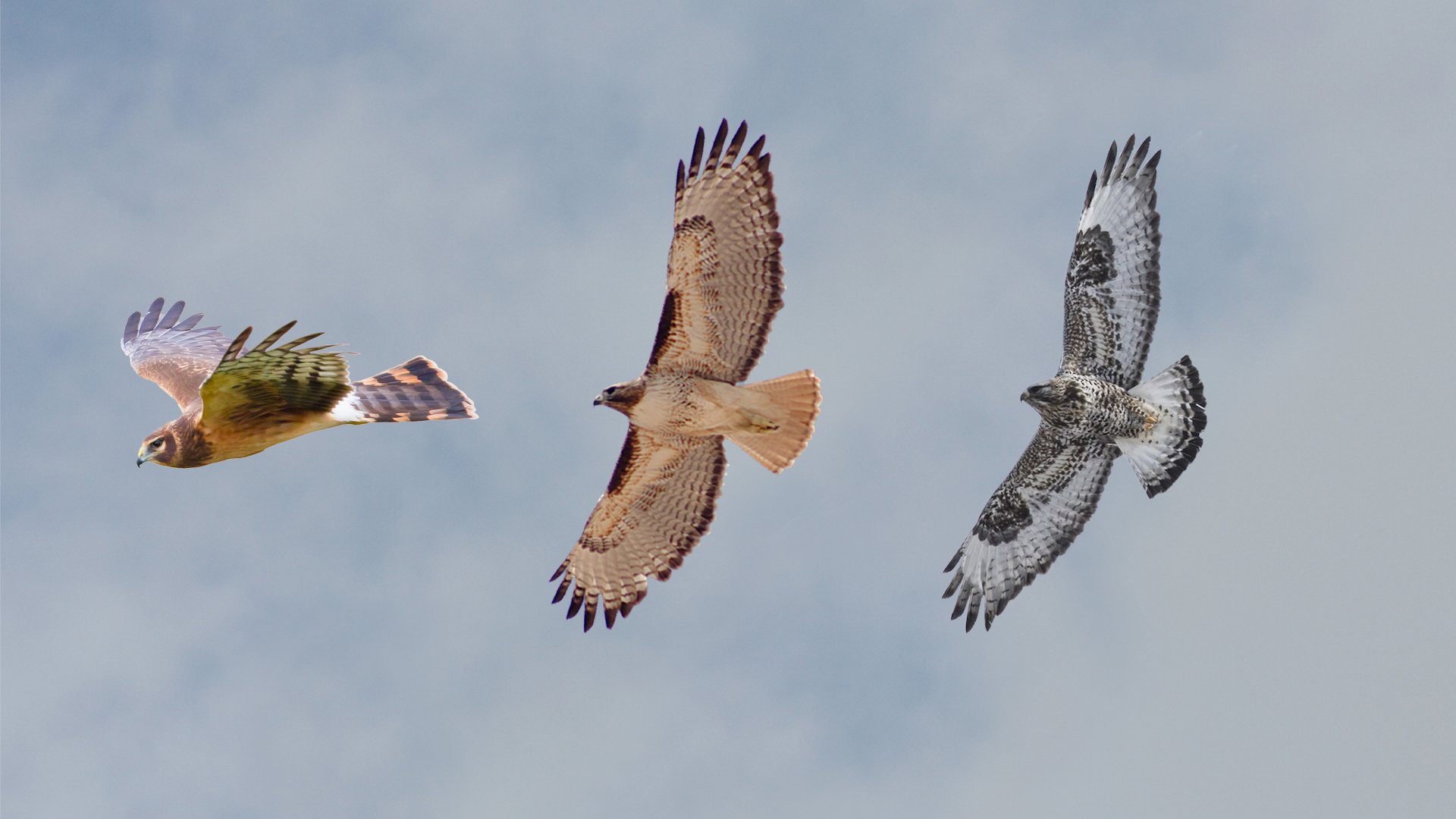
Left to right: Northern Harrier, Red-Tailed Hawk, Rough-Legged Hawk
Understanding seasonality, body plans, and flight styles is essential to understanding birds of prey at a distance. Is the bird large and flying flat, holding its wings in a vee and tilting as it flies, or M-shaped? If you are in northeastern Iowa during the summer, the first is probably an eagle, the second is probably a turkey vulture, and the third is probably an osprey. Is that far-away eagle perched near water in a large group, or high and aloof on a rocky formation back in a forested draw? If you are in northeastern Iowa in the winter, the first might be a Bald Eagle and the second might be a Golden Eagle.
Still not sure about bird ID? Some more helpful questions: Are the bird’s wings large or small in proportion to the rest of it? Are they pointed or rounded? Broad or narrow? Is the bird’s tail long or wedge-shaped? Is the bird flapping and gliding, diving, hovering, or quartering low over a field? Did you see it in the woods, in the open, or near water? All birds have wings, and all birds of prey have keen vision, talons, and curved beaks. But not all wings, beaks, talons, and hunting styles are the same. As Jerry Ligouri points out, the most important aspects regarding in-flight hawk ID are shape and flight style. To improve your ID skills, especially if a bird isn’t nicely posed in binocular or scope range, learn the basics: where the species is, when it is there, what it does, and how it does it.
Did you know?
People often compare birds to aircraft, with mixed results. Aircraft can’t change their shape, but birds can and often do change shape as they fly! I chose silhouettes that I thought best represented each bird overall, but birds use different flying styles under different conditions, even if they can’t change their overall body plan.
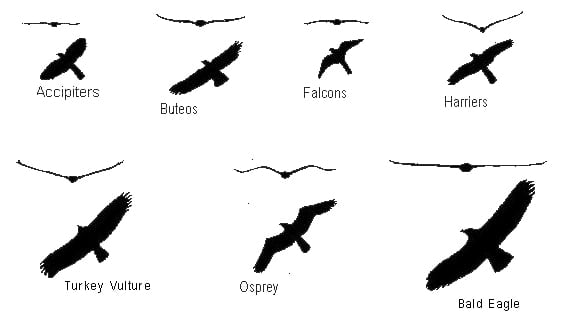
Silhouettes of birds of prey in flight from learner.org
Photo credits
- Northern Harrier, Dan Pancamo, Wiki Commons
- Rough-legged Hawk, dfaulder, Wiki Commons
- Red-tailed Hawk, Alan Vernon, Wiki Commons
- Osprey, Denny Swaby, Macauley Library
- Golden Eagle, Benjamin Hack, Macauley Library
- Bald Eagle, Amada44, Wiki Commons
- Turkey Vulture, Dori, Wiki Commons
- Composites: Amy Ries
Things that helped me learn about this topic
 The Raptor Resource Project
The Raptor Resource Project The Raptor Resource Project
The Raptor Resource Project